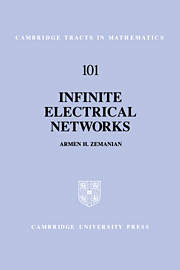7 - Grids
Published online by Cambridge University Press: 05 February 2012
Summary
Perhaps the most important infinite electrical networks with respect to physical phenomena – putting aside the finite networks – are the infinite grids. This is because finite-difference approximations of various partial differential equations have realizations as electrical networks whose nodes are located at the sample points of the approximation. Those sample points are distributed in accordance with increments in each of the coordinates, hence the gridlike structure. Moreover, if the phenomenon exists throughout an infinite domain, it is natural (but, to be sure, not always necessary) to choose an infinity of sample points. In this way, one is led to infinite electrical grids as models for the so-called “exterior problems” of certain partial differential equations. Two cases of this were presented in Section 1.7, and more will be discussed in the next chapter. The grids we examine are of two general types: the grounded grids, wherein a resistor connects each node to a common ground node, and the ungrounded grids, wherein those grounding resistors are entirely absent. Grounded grids are readily analyzed, but ungrounded grids are more problematic because of a singularity in a certain function that characterizes the network.
This chapter is devoted to rectangular grids, the natural finite difference model for Cartesian coordinates, but the analysis can be extended to other coordinate systems such as cylindrical and spherical ones [180], [183], [184], [188].
- Type
- Chapter
- Information
- Infinite Electrical Networks , pp. 215 - 266Publisher: Cambridge University PressPrint publication year: 1991

